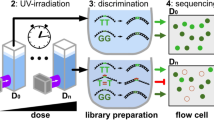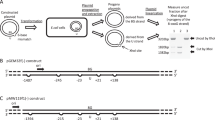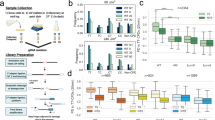Abstract
The frequency of UV-induced mutations at specific nucleotides along the lacI gene of Escherichia coli varies by as much as 80-fold1. The spectrum of mutations to amber, ochre, and UGA chain-terminating codons includes five hotspots accounting for over 30% of these UV-induced nonsense mutations1. The simplest explanation for the hotspot phenomenon is that the mutation frequency reflects the frequency of UV-induced DNA damage at the mutation site. To test this possibility, we measured the distribution, in a 380-base pair (bp) region of the lacI gene containing the nonsense mutation hotspots, of UV-induced cyclobutane pyrimidine dimers and pyrimidine–pyrimidine (6-4) photoproducts. The latter (also called the PydC lesion) is a UV-induced DNA lesion which occurs predominantly at TC and CC sequences2. The results reported here reveal the presence of UV-induced base damage hotspots which include the nonsense mutation hotspots. There is a linear relationship between base damage incidence and mutation incidence. The results suggest that the UV-induced pyrimidine–pyrimidine (6-4) lesion may be mutagenic.
This is a preview of subscription content, access via your institution
Access options
Subscribe to this journal
Receive 51 print issues and online access
$199.00 per year
only $3.90 per issue
Buy this article
- Purchase on Springer Link
- Instant access to full article PDF
Prices may be subject to local taxes which are calculated during checkout
Similar content being viewed by others
References
Coulondre, C. & Miller, J. H. J. molec. Biol. 117, 525–567 (1977).
Lippke, J. A., Gordon, L. K., Brash, D. E. & Haseltine, W. A. Proc. natn. Acad. Sci. U.S.A. 78, 3388–3392 (1981).
Haseltine, W. A., Lindan, C. P., D'Andrea, A. D. & Johnsrud, L. Meth. Enzym. 65, 235–248 (1980).
Haseltine, W. A. et al. Nature 285, 634–641 (1980).
Varghese, A. J. & Wang, S.-Y. Science 156, 955–957 (1967).
Wang, S.-Y. in Photochemistry and Photobiology of Nucleic Acids Vol. 1 (ed. Wang, S.-Y.) 295–356 (Academic, New York, 1976).
Drake, J. W. J. molec. Biol. 6, 268–283 (1963).
Howard, B. & Tessman, I. J. molec. Biol. 9, 372–375 (1964).
Osborn, M., Person, S., Phillips, S. & Funk, F. J. molec. Biol. 26, 437–447 (1967).
Brandenburger, A. et al. Nature 294, 180–182 (1981).
Kato, T., Shinoura, Y., Yemplin, A. & Clark, A. J. J. molec. gen. Genet. 180, 283–291 (1980).
Miller, J. H. & Schmeissner, U. J. molec. Biol. 131, 223–248 (1979).
Witkin, E. M. Science 152, 1345–1353 (1966).
Witkin, E. M. Bact. Rev. 40, 869–907 (1976).
Bridges, B. A. Mutat. Res. 3, 273–279 (1966).
Coulondre, C. & Miller, J. H. J. molec. Biol. 117, 577–606.
Gordon, L. K. & Haseltine, W. A. J. biol. Chem. 255, 12047–12050 (1980).
Author information
Authors and Affiliations
Rights and permissions
About this article
Cite this article
Brash, D., Haseltine, W. UV-induced mutation hotspots occur at DNA damage hotspots. Nature 298, 189–192 (1982). https://doi.org/10.1038/298189a0
Received:
Accepted:
Issue Date:
DOI: https://doi.org/10.1038/298189a0
This article is cited by
-
Sequence dependencies and mutation rates of localized mutational processes in cancer
Genome Medicine (2023)
-
Preparation of Photo-responsive DNA Supramolecular Hydrogels and Their Application as UV Radiometers
Chemical Research in Chinese Universities (2023)
-
Global genetic diversity, introgression, and evolutionary adaptation of indicine cattle revealed by whole genome sequencing
Nature Communications (2023)
-
Genome-wide mapping of genomic DNA damage: methods and implications
Cellular and Molecular Life Sciences (2021)
-
Exome sequencing identifies novel mutation signatures of UV radiation and trichostatin A in primary human keratinocytes
Scientific Reports (2020)
Comments
By submitting a comment you agree to abide by our Terms and Community Guidelines. If you find something abusive or that does not comply with our terms or guidelines please flag it as inappropriate.



